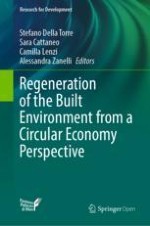In the product and process development of more eco-friendly coated textiles, or a woven or non-woven membrane for architectural application, a double verification of their eco-efficiency (matter level) and environmental performances (building level) is in parallel needed. The LC analysis phase, as appears in Table
2, can provide an early stage evaluation of environmental impacts of a novel design concept and/or a material choice assumption. At that stage, a comparative LCA allows, on one hand, to check the environmental impacts generated during the production of alternative materials, on the other hand, to deepen the eco-profile’s incidence of different technical solutions. A building level LCA investigation takes into account the efficiency of the whole system, the efficacy of the foreseeing construction procedures, the structural and thermo-physic and acoustic performances, as well as the costs. In the road map of the eco-efficiency of textiles for architecture, different stakeholders can be associated to the life cycle steps, above all: the chemical industry and the producers of polymeric/bio-based/biodegradable yarns and fabrics, on one side, and the supply companies of tailoring and assembly of the membrane components for the architecture to the other.
The considered scientific sources on the environmental impact assessment of textile and finishing industries clearly show that the investigation of the environmental impacts of the textile industry for clothing, furniture cladding and internal architecture has been started some decades ago, while the interest of the environmental burden of coated membranes and films for architecture starts recently. In general, literature surveys and other LCA studies on textiles show that most of the available process data are still not fully readable and clearly outliers. At the material’s production level, TU Delft provided an up-to-date insight into the environmental burden of cotton, polyester, nylon, acryl, and elastane-based textiles (Van der Velden et al.
2014). The Institute of Textiles at Hong Kong Polytechnic developed a way to quantify and rank the ecological sustainability of textile fibers, such as organic cotton, flax, viscose, polyester, polypropylene, acrylic, and nylon (Smith and Barker
1995). The eco-efficiency of textile wet processing in Finland was also studied, as a part of drafting the Best Available Technique Reference documents for the European IPPC Bureau (Bidoki and Wittlinger
2010). Since 2004, Swedish Chalmers University of Technology has been focusing on LCA of textile products used for furniture wrapping (Subramanian et al.
2012), contributing at the adaptation of the LCA methodology to the textile sector specificities, and identifying the basis for a simplified evaluation tool, useful for textile companies. The EU COST Action 628 tried to define the best available technology (BAT) of textile processing and eventually suggested criteria for ISO (Type III) Environmental Product Declaration (EPD) standards (Kalliala and Talvenmaa
2000). In the field of textile architecture, the authors, as leaders of the
Sustainability and LCA working group of a European project focused on the sustainability improvement of structural textiles (COST Action TU1303
2017), are working on the development of EPDs of membranes and foils, as well as defining their data quality requirements, transferable into Product Category Rules (PCR) documents. Furthermore, a significant eco-design approach for textile architecture can pass from the definition of brief design principles for weight reduction and the efficient of form-structure membrane skins (Monticelli and Zanelli
2019). The TAN group’s authors collaborated with EU-funded EASEE project, assessing the environmental impacts of various textile finishing layers for inner walls, considering to cover an area of 3 m
2 as functional unit (Masera et al.
2017). A wide range of textile-based wallpapers and other less flexible finishing solution was then analyzed. Basing on this documented comparison between nature-based and fossil-based textiles (Table
4), the complexity of the LCA approach clearly tends to increase if we do not only look at the production of a new bio-textile—compared to a fossil-based one—but we want to measure its eco-efficiency throughout its service time and final disposal. This comparative LCA needs to: (a) identify key parameters and phases in the whole life cycle aiming to an improvement of the ecological efficiency of the product; (b) optimize the life cycle stage in relation to various disposal scenarios (recycling, incineration, landfill); and (c) carry out an life cycle costing (LCC) evaluation to identify the main cost contributions of the new bio-based textiles and find ways to optimize them.
Table 4Different textile inner finishing layers–LCA results
Abiotic depletion (kg Sb eq) | 0.0115 | 0.0014 | 0.0051 | 0.00461 |
Acidification (kg SO2 eq) | 0.0183 | 0.0016 | 0.0020 | 0.0041 |
Eutrophication (kg PO4—eq) | 0.0038 | 0.0013 | 0.0010 | 0.0007 |
Global warming GWP100 (kg CO2 eq) | 1.9302 | 0.2393 | 0.7110 | 0.6800 |
Ozone layer depletion (ODP) (kg CFC-11 eq) | 0.000000041 | 0.000000011 | 0.000000092 | 0.000000027 |
Human toxicity (kg 1,4-DB eq) | 0.7634 | 0.1077 | 0.6625 | 0.3969 |
Freshwater aquatic ecotox (kg 1,4-DB eq) | 0.9811 | 0.1042 | 0.1582 | 0.1206 |
Marine aquatic ecotoxicity (kg 1,4-DB eq) | 915.9794 | 210.4671 | 333.6373 | 234.1596 |
Terrestrial ecotoxicity (kg 1,4-DB eq) | 0.0739 | 0.00056 | 0.0022 | 0.0038 |
Photochemical oxidation (kg C2H4 eq) | 0.0006 | 0.000043 | 0.00017 | 0.00019 |
Non-renewable, fossil (MJ eq) | 20.6502 | 3.8076 | 12.0287 | 10.1658 |



